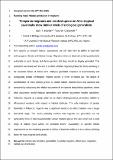Files in this item
Temperate migrants and resident bird species in Afro-tropical savannahs show similar levels of ecological generalism
Item metadata
| dc.contributor.author | Ivande, Sam T. | |
| dc.contributor.author | Cresswell, Will | |
| dc.date.accessioned | 2017-04-09T23:33:12Z | |
| dc.date.available | 2017-04-09T23:33:12Z | |
| dc.date.issued | 2016-07 | |
| dc.identifier | 241881116 | |
| dc.identifier | e5f068e2-9c2b-4860-adc5-4c866edd9f22 | |
| dc.identifier | 84963699377 | |
| dc.identifier | 000378415800003 | |
| dc.identifier.citation | Ivande , S T & Cresswell , W 2016 , ' Temperate migrants and resident bird species in Afro-tropical savannahs show similar levels of ecological generalism ' , Ibis , vol. 158 , no. 3 , pp. 496-505 . https://doi.org/10.1111/ibi.12371 | en |
| dc.identifier.issn | 1474-919X | |
| dc.identifier.other | Bibtex: urn:d20c7dfbd78b9a7002b57f742e7d571e | |
| dc.identifier.other | ORCID: /0000-0002-4684-7624/work/60426920 | |
| dc.identifier.uri | https://hdl.handle.net/10023/10597 | |
| dc.description | We are grateful to the Leventis Conservation Foundation for funding this research and wish also to acknowledge and thank staff and field assistants at the A.P. Leventis Ornithological Research Institute (APLORI), Jos, Nigeria, for help with field travel and logistics. | en |
| dc.description.abstract | The specificity of an animal's habitat requirements will determine its ability to deal with anthropogenic climate and habitat change. Migratory birds are thought to be particularly vulnerable to such change, but theory predicts that they should be largely generalists. This prediction was tested with the aim of assessing whether migratory Palaearctic-breeding birds wintering in the savannah biome of Africa are more or less generalist in their habitat use compared with taxonomically and ecologically similar Afro-tropical resident species. The degree of specialization of these species groups to certain habitat characteristics was assessed and compared by calculating the relative occurrence of the species along habitat gradients, where wide occurrence indicates generalism and narrow occurrence indicates specialism. Palaearctic migrants as a group could not clearly be distinguished as generalists relative to Afro-tropical residents with respect to habitat attributes. The only indication of greater flexibility in Palaearctic migrants was a significant tendency to use habitats over a wider latitudinal range. The results suggest that migrants are generalists, but not necessarily more generalist than taxonomically similar resident species that also occur over a wide range of habitat types within the savannah biome. The availability of specific habitat requirements on the wintering grounds in Africa is therefore unlikely to be a primary limiting factor for many Afro-Palaearctic migratory bird species. | |
| dc.format.extent | 1052464 | |
| dc.language.iso | eng | |
| dc.relation.ispartof | Ibis | en |
| dc.subject | Afro-tropics | en |
| dc.subject | Distribution | en |
| dc.subject | Generalists | en |
| dc.subject | Habitat specialization | en |
| dc.subject | Habitat use | en |
| dc.subject | Migration | en |
| dc.subject | Palaearctic migrants | en |
| dc.subject | QH301 Biology | en |
| dc.subject.lcc | QH301 | en |
| dc.title | Temperate migrants and resident bird species in Afro-tropical savannahs show similar levels of ecological generalism | en |
| dc.type | Journal article | en |
| dc.contributor.institution | University of St Andrews. School of Biology | en |
| dc.contributor.institution | University of St Andrews. Scottish Oceans Institute | en |
| dc.contributor.institution | University of St Andrews. Institute of Behavioural and Neural Sciences | en |
| dc.contributor.institution | University of St Andrews. St Andrews Sustainability Institute | en |
| dc.contributor.institution | University of St Andrews. Centre for Biological Diversity | en |
| dc.identifier.doi | https://doi.org/10.1111/ibi.12371 | |
| dc.description.status | Peer reviewed | en |
| dc.date.embargoedUntil | 2017-04-09 |
This item appears in the following Collection(s)
Items in the St Andrews Research Repository are protected by copyright, with all rights reserved, unless otherwise indicated.

